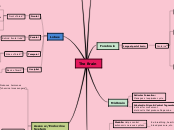The Brain
Spinal Cord
Connects to brain stem,
extends to around the edge
of ribcage
Nerves extend out
Sensory nerves:
Take messages to brain
Motor nerves:
Send messages out
Protected by vertebrae
Forebrain
Largest part of brain
Contains
Thalamus
"Sensory relay"
All senses other than smell
processed here
Pituitary Gland
"Messenger hormones":
Control all endocrine glands
Produces growth hormones,
endorphins, and manages fluid
levels
Limbic System
3 Most Imp. Parts
Hippocampus:
Learning & memory
Amygdala:
Manages emotion and memory,
and the relationship between the two
Hypothalamus:
Regulates a number of
homeostatic processes
Ex: Body temp,
appetite, blood pressure,
etc.
Used as connection between
endocrine system & nervous syst.
Midbrain
Reticular Formation:
Manages sleep/wake cycle
Substantia Nigra & Ventral Tegmental Area:
-Critical for movement
-Hold cells that produce Dopamine
Help manage mood,
reward, addiction
Hindbrain
Medulla: Helps control
autonomic nervous system
Ex: breathing, heart rate,
blood pressure, etc.
Pons: Connects brain to
spinal cord
Helps manage brain
activity during sleep
Cerebellum:
Controls movement, balance,
motor skills
Helps process certain
kinds of memories
Appearance/2 Hemispheres
Surface=Cerebral Cortex
Bumps=Gyri
Grooves=Sulci
Longitudinal Fissure
Long cleft that separates
2 hemispheres
Connected by Corpus Callosum
Band of neural fibers, allows
communication between 2
hemispheres
-Left hemisphere controls right side of body
-Right hemisphere controls left side of body
Lobes
Frontal
Front of brain
Prefrontal cortex:
Manages high-level
functioning
Motor cortex:
Plans, coordinates
movement
Broca's Area:
Langauge
Parietal
Behind frontal lobe
Somatosensory Cortex:
Processes sensory data
Touch, temperature,
pain, etc
Temporal
Sides of brain
Auditory Cortex:
Processes auditory
(hearing) info
Wernicke's Area:
Speech understanding
Occipital
Back of brain
Primary visual cortex:
Processes visual info
Assoc. w/ Endocrine
System
Produces hormones
("chemical messengers")
Hormones pushed
into blood stream
Important Glands
Pituitary
"Master Gland";
Controls all other glands in
endocrine system
Body temp., growth hormones,
regulates body fluid levels
Thyroid
Located in neck: Responsible for growth,
metabolism, appetite, etc
Adrenals
Glands sit on top of kidneys,
produce hormones associated
w/ stress response
Epinephrine (adrenaline)
Norepinephrine (noradrenaline)
Pancreas
Abdominal internal organ,
secretes hormones to regulate
body's blood sugar
Insulin (lowers blood sugar)
Glucagon (raises blood sugar)
Gonads
Female: Ovaries
Male: Testes
Excretes sexual hormones important
for sexual motivation, reproduction
Medulla, Pons, & Midbrain:
Together referred to as the
brain stem
Cells of the Nervous System
Glial Cells
Provides "building blocks" of nervous system
Helps neurons align for neural communication
Provides insulation to neurons
Moves nutrients and waste products
Mediates immune responses
Inside Axons, Glial cells form
Myelin Sheaths that act as insulation
to Axon
This increases signal speed
Neurons
(Info Processors)
Soma (Body of Cell)
Outer surface:
Semipermeable membrane
Contains nucleus of neuron
-Allows small molecules, and
molecules with smaller charge.
-Larger molecules and molecules with
higher charge unable to permeate cell
Dendrites:
Branches that extend outward
Electrical signals cross Soma.
and down extension called Axon
Axon ends at Terminal Buttons
Contains synaptic vesicles that
hold neurotransmitters
Terminal Buttons discharge
neurotransmitters into Synapse
Synapse: Tiny space between
two neurons
Neurotransmitters pass across
Synapse, merge with Receptor of
adjacent Neuron
Certain neurotransmitters fit
into certain Receptors, often called
"lock and key" relationship
